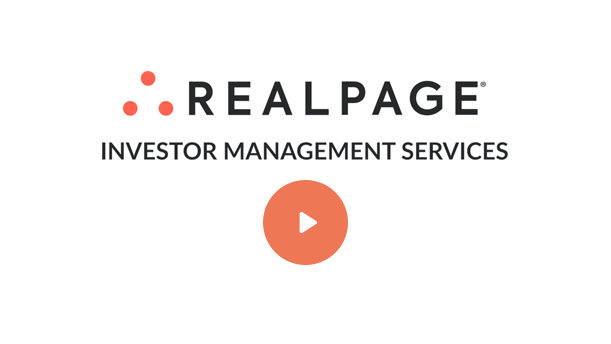Engage stakeholders and maximize portfolio progress with end-to-end investor management and reporting.
The Investor Management Services (IMS) platform is the leader in investment management software with the first complete technology solution designed to give private equity real estate firms the advantage to manage outside investors and outmaneuver the market.
RealPage® IMS focuses on expanding investor transparency and engagement by combining performance insights with CRM capabilities, document distribution and a centralized location for new offerings to deliver a modern experience for real estate investment firms and syndicators as well as fund and portfolio managers:
- Efficient, targeted communication tools to engage current and prospective investors
- Self-service performance dashboards/KPIs, returns, calculations and analytics
- Pipeline tracking and fundraising automation
- Automated waterfall calculations and custom statement generation
Strengthen Relationships, Responses & Results
Improve Investor Transparency
Keep up with changing expectations for investment management with a more comprehensive dashboard that ties each investor’s portfolio and performance information to their distribution and statement information. Available 24/7, RealPage IMS is one of the industry’s only all-in-one software solutions for investor management.

Reduce Investor Support Time
Optimize your team’s time and resources by delivering more efficient investment management services with streamlined support for administrative activity ranging from answering distribution questions to resending K-1s to updating investor contact and bank details — allowing more focus on high-value tasks and interaction.

Raise Capital Faster
The clock starts immediately on a new investment acquisition to expedite, simplify and streamline the capital raise process. To help pull the pieces together and close as quickly as possible, the IMS platform dramatically reduces the time and effort to raise equity, including marketing to investors, distributing deal documents, managing electronic signatures and receiving funds.

Minimize Time to Calculate Distributions
Calculating accurate distributions for your equity investors is necessary, but managing complex waterfalls in fragile Excel spreadsheets is time-consuming and prone to errors and security risks. IMS simplifies and automates your distributions to speed delivery, improve accuracy and ensure you can scale easily as you grow your business.

Protect Your Investor Data
The IMS solution is designed to prevent security breaches using banking- and military-level encryption and housed in the largest and most advanced cloud hosting platform. Our cloud operations team adds an extra layer of protection with proactive policies and measures to detect and address potential security issues.
End-to-End Security Highlights:
- Data in motion encrypted using 256-bit SSL
- Data storage using the same AES 256-bit encryption technology as banks and the U.S. military
- Dedicated operations team to monitor platform security and maintain updated security patches, virus protection and malware protection
- Suspected security issues immediately trigger an investigation to rule out any breaches
- Hosted in Amazon Web Services, the largest cloud infrastructure provider for leading financial services companies
In addition to rigorous data security standards, IMS implements a robust data consistency policy to protect your data in the unlikely event of any system issues.
Backup and Data Consistency Highlights:
- Real-time backups (every second of every day) stored for 30 days
- Hourly backups stored for 30 days plus daily backups stored for 1 year
- All backups are fully encrypted
Our cloud operations team constantly monitors our system using industry-leading software solutions to ensure maximum security and consistency for your portfolio and investor data.
Modernize the Investing Experience
Centralized CRM
Manage stakeholder relationships efficiently using a CRM tailor-made for commercial real estate firms that puts all investor and partner information at your fingertips. By accessing a single source of truth in IMS, sponsors can easily locate contact details, track engagement, surface communication history and view investment activity from a secure portal.
Automated Distribution Waterfalls
Eliminate Excel-based risk and time-consuming manual processes with the only platform built to calculate waterfalls and process distributions in minutes. Designed for efficiency and repeatable accuracy, IMS automates your waterfall workflows and keeps your investment data in a single view.
Investor Dashboards
Exceed investors’ expectations for better transparency, access and response with dashboards that accelerate capital raises while saving time and resources. With the IMS Investor Dashboard, your firm can close faster and keep investors involved in the online deal room using digital deal documents, electronic signature automation and historical performance records.
Investor Statements Online
Build trust and credibility with commercial real estate investors by giving them the investment access and transparency they demand. The IMS platform maintains an open exchange of information through secure account statements available on demand, 24x7, facilitating smoother transactions and faster response to opportunities.
Commitments & Capital Calls Coordination
IMS makes planning, requesting and collecting commitments for new capital raises easy, consolidating communication tasks and processing commitments to allow sponsors to focus on managing investor relationships. When you’re ready to call capital, IMS helps you notify investors of current capital needs, track incoming funding and quickly calculate outstanding capital.
Document Management
The IMS platform includes a document management system — effectively a built-in deal room — to streamline the delivery of secure forms, reports and updates to investors and employees. Through the investor dashboard, you can easily share individual K-1s with a single investor or send project-specific data to multiple investors participating.
Timely Property Insights
With the Key Property Insights feature, automated data aggregation and visualization across your asset portfolio give you the opportunity to optimize value, including with multiple third-party property managers. IMS serves up intuitive and interactive dashboards that empower you to pinpoint inefficiencies, identify actionable next steps and maximize performance.
